How to be a DJ
A guide to starting a DJ career
So you want to be a DJ? But do you know how to DJ?
You’ll find tutorials and advice spread around the internet but I wanted to create something to help beginners and intermediates understand how to become DJ, how to mix, how to understand music and the crowd you’re DJ-ing to.
So here’s my definitive guide to DJ-ing. This will get you started on the road to DJ stardom!
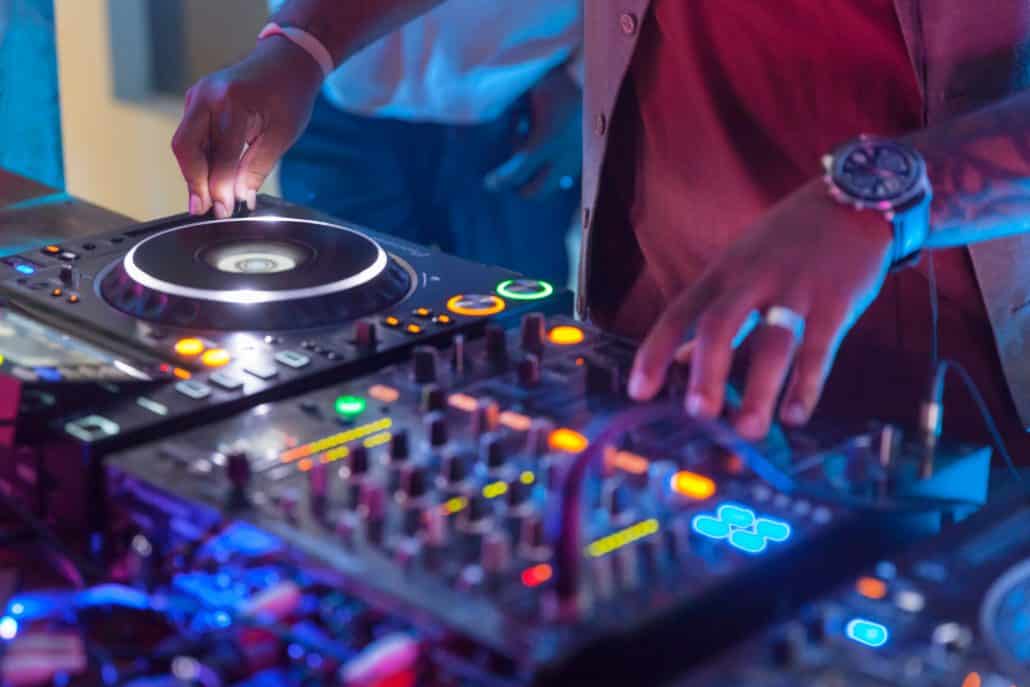
The first thing you’ll have to do is answer this one simple question… What type of DJ am I?
It’s what will give you direction and make it clear what skills you really need to focus on.
Here’s the 5 key types of DJ. Which one are you?
Club DJ
 One of the most common forms of DJ and quite possibly the type of DJ you want to be.
One of the most common forms of DJ and quite possibly the type of DJ you want to be.
You don’t have to tour the world doing massive gigs to get to play to high-energy crowds every night. If you can secure a club residency, or tour your local circuit, then you’ll soon be able to make a name for yourself.
You’ll find DJs of all abilities pursuing this route, and it’s because it offers a stable income, it’s fun, and it gets you plenty of crowd interaction.
Mobile DJs
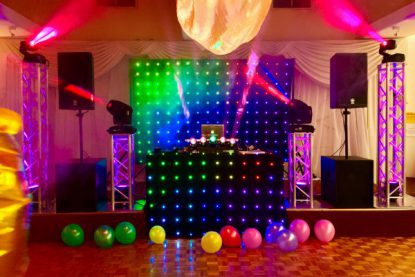 If you want to travel far and wide DJ-ing at a whole host of functions and events both corporate and personal, a mobile DJ is what you need to be.
If you want to travel far and wide DJ-ing at a whole host of functions and events both corporate and personal, a mobile DJ is what you need to be.
You’re going to need to be flexible and adaptable, and adept at setting up your kit in some pretty unusual places.
If you want to connect with more intimate audiences and play somewhere different every night, then this may be the type of DJ for you. It offers great variety, you’ll be DJ-ing at important events for your crowds like weddings and birthday parties as well as product launch parties and Christmas work parties.
Being this type of DJ requires more investment in hardware and the ability to transport it all and set it up yourself. I’ve written a detailed guide on how to become a disco DJ here. Definitely worth a read if this is your calling.
DJ / Producers
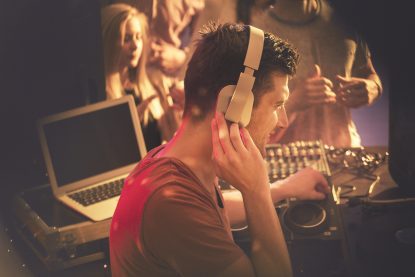 You might not think of dance music producers as DJs, but many of them are. These are the mysterious DJs who seem to spend their lives hidden away in their studios, perfecting a beat that will one day take the world by storm! Is this your calling?
You might not think of dance music producers as DJs, but many of them are. These are the mysterious DJs who seem to spend their lives hidden away in their studios, perfecting a beat that will one day take the world by storm! Is this your calling?
They also get the chance to work with a huge variety of other artists, so if you want to collaborate and explore a range of genres, this is the way to go. They rarely play nightclubs, in fact their DJ-ing career depends entirely on the music production. Getting recognition for the tunes they create and often touring the nation or the world playing large capacity venues.
To be a producer you’ll need skills beyond just knowing how to mix. Being able to play the piano is a must as nearly all synthesised sounds will require a keyboard.
You’ll need plenty of time and motivation to pull this off but if you do the sky’s the limit!
Or at the very least you’ll have your own original sounds to play when you DJ.
Radio DJs
 These are the DJs you hear first thing in the morning on your way to work, and it’s safe to say they love a good chat. Their skill is about more than just music, it’s about offering all-round entertainment. So you’ll need to be eloquent and versatile in conversation.
These are the DJs you hear first thing in the morning on your way to work, and it’s safe to say they love a good chat. Their skill is about more than just music, it’s about offering all-round entertainment. So you’ll need to be eloquent and versatile in conversation.
If you like to keep your ear to the ground when it comes to new releases, and you want to build an audience step by step, pursuing a career as a radio DJ could be the way to go.
And thanks to the world of podcasting and internet radio stations you won’t have to wait to be signed by a major station to get out there on the airwaves.
You’ll be surprised to know almost all famous radio DJs worked their way up from local community radio stations, carving a niche for themselves either through presenting style or expertise in a particular type of music. So if you’re an expert on deep house or know how to DJ drum and bass and you think you could talk endlessly about it, then maybe this is the career for you.
So which DJ do you want to be?
Regardless of the answer you’ll need to know the following skills to make a success of your DJ career. All of these are great skills to have and will see you through the good times and bad in your DJ career.
Reading the crowd is one of the central skills of being a DJ, but unfortunately you can’t take a course that guarantees you’ll always be able to do it.
The secret is to take onboard the following wise words, and then spend hours putting them into practice.
It might feel a little daunting at first, but it’ll certainly be worth it in the long run.
Here we go!
The Warm Up Set
Most people don’t walk in the club bouncing off the walls and ready to party like the night will never end — you need to make them feel that way.
If you go straight into your most intense track of the night early doors you’re not going to get the crowd reaction you were hoping for. You’re also not going to have anything left in reserve to build them up to later on.
This is the problem a warmup set solves, and its purpose is to get people excited and moving more and more. Start with less intense tracks that set the atmosphere just right, and gradually increase the intensity over the course of your set to warm the crowd up.
This applies to all types of DJs. You can ruin someone’s wedding if you don’t read the energy of the crowd just right. See what the mass of people are connecting with, be prepared to cut short any track that kills the dance floor and move on to something that is compatible with their current mood.
DJ TLM does a great job of explaining the importance of track selection for a warm up set. Well worth a quick watch.
Versatility is the key, if you get it right you can have the crowd eat out the palm of your hand. Get it wrong and they will not be impressed.
The Drop
Once you have the whole crowd excited and ready for more, it’s time for the drop.
This the part of the night where your main set sparks into life, and it can quickly become your signature if you get it right. It’s all about building up the energy in your set to a frenzy, even teasing the crowd before you let rip with your signature move.
 If you want to be a club DJ its all about playing your tracks in the perfect order, reading the crowd’s responses and eventually giving them what they’ve all come for, that amazing moment when whatever you play is the best moment of their life!
If you want to be a club DJ its all about playing your tracks in the perfect order, reading the crowd’s responses and eventually giving them what they’ve all come for, that amazing moment when whatever you play is the best moment of their life!
You have the power to do that, if you can learn what makes your crowd move and estimate how they will respond.
If you going to be a mobile DJ then your crowd are up for a different kind of party. They want anthems and lots of them. Make sure you get a list of the bride and groom’s favourite pop, rock and dance anthems. Generally speaking their favourites are often their friend’s favourites too so with this list you’re on to a winner.
The drop at a private wedding or birthday party is a much shorter and more intense affair that can be repeated throughout the evening. Its all about picking the right moment. You can build up to it with tunes of increasing energy and tempo, or you can surprise them with a quick cut mix and literally drop the track suddenly for the total shock factor.
The drop applies to producers and radio DJs too. If you’re producing then you can make your own drops or create remix loops and beds you can play over other producer’s tracks. If you’re a radio DJ then its all about saving the most popular and high energy tunes for the right part of your time-slot.
A drop doesn’t happen at the start or end of a set, its all about timing. Pick the right moment, read the crowd right and slay them with your best tunes at just the right time.
Playing with the crowd
As the set progresses you may want to play around with the intensity in bursts to keep the crowd on their toes (quite literally).
 You want to keep getting them amped up and excited about what could possibly come next, increasing the intensity each time you do so.
You want to keep getting them amped up and excited about what could possibly come next, increasing the intensity each time you do so.
There’s no definite formula you can follow here that’ll always work, so make sure you pay attention to the look and vibe of the crowd each time you drop something new. Only then will you see how to really be a DJ. We’ve written an article all about the art of reading the crowd to be a better DJ.
Many people think its all about beat-matching and transition styles but the real DJ skill comes from knowing what to play and when, and more importantly when to move on to the next track for maximum crowd pleasure.
Watch how they dance, are they super passionate? Are they more passionate about the current track than the last? Can you see they’re getting more and more in to the music you’re playing?
If you can master this then you’ll be a real high quality DJ.
Changing Your Set On the Go
This is one of the hardest things to do when you’re a new DJ, but it will be crucial if you want to make a name for yourself.
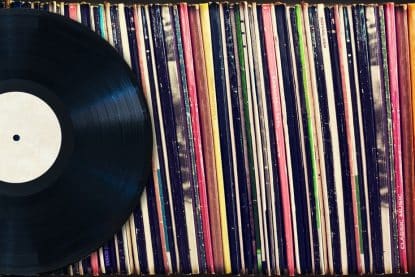 There’s always going to be cases when even the most tried and trusted set falls flat, so make sure you have a few other musical avenues in reserve.
There’s always going to be cases when even the most tried and trusted set falls flat, so make sure you have a few other musical avenues in reserve.
I always have a few backup playlists ready and waiting should the direction I wanted to take the set in just not gel with the crowd.
Over time you’ll get better at understanding the venue, its atmosphere and the people that go there. So a plan B isn’t used so often, but its always important to have something else to play if they’re just not feeling it.
Also if you get too used to playing the same old set night after night, you’re going to get stale. Take your music in a new direction however, and you’ll able to react to the vibe of the room with ease.
Shoutouts and requests
If you’re a mobile DJ and sometimes a bar or club DJ you’ll get used to doing this. Punters often demand requests so you need to get used to dealing with whatever the crowd might be shouting at you and getting on the mic to give the shoutout.
It’s a great way to get a bit more of your personality and signature style out there, and the crowd will appreciate it more than you realise.
 Mobile DJs are pretty much expected to take requests so you’ll need a wide and varied library of music at your disposal. You could DJ using Spotify too which I’ve written about, or buy a large media library in bulk from an online store.
Mobile DJs are pretty much expected to take requests so you’ll need a wide and varied library of music at your disposal. You could DJ using Spotify too which I’ve written about, or buy a large media library in bulk from an online store.
Seasonal Classics
Music is all about having fun, and what better way to do that than with a few seasonal classics the crowd all know and love?
 Christmas, summer, Valentine’s Day, you name it there’ll be a dozen songs they’re hoping you’re going to play.
Christmas, summer, Valentine’s Day, you name it there’ll be a dozen songs they’re hoping you’re going to play.
You don’t want to play only seasonal tunes, but if you can pepper them throughout your set, and when you’re winding down at the end, it’ll help you make a name for yourself.
The more creative and original you can be the more you’ll get noticed, the more gigs you’ll get and the more you can charge per gig.
So find ways to do things other DJs are not. Musical themes, remixes, mashups and surprises are just a few of the ways you can do this.
Getting the Length Right
There’s no better way to disappoint an audience than by only giving them 10 minutes of bangers and a bunch of fillers. You need to be creative and dynamic 100% of your time-slot.
This applies to all types of DJ.
If you’re playing back to back with a number of other DJs then make sure you respect the time slot you’ve been allotted — you wouldn’t like it if another DJ overran, would you?
Know how long your set is, plan to take your crowd on a journey for that time period, if there’s breaks (like speeches at weddings) then take those in to consideration.
The better prepared you are the more professional you will appear to your crowd and most importantly your client.
Find Your Place in the Running order
 If you want to find your feet as a new DJ then you don’t want to be on first, or last.
If you want to find your feet as a new DJ then you don’t want to be on first, or last.
Going on first can be hard as the place will only just be filling up and its much harder to read the crowd or have any lasting impact on them.
Going on last often sets the expectation levels sky-high, which is not what you want when you’re still perfecting your DJ skills.
Aim for the earlier part of the middle section so you can get some crowd interaction, but you’re not so close to the end of the night that you’ll have the expectation of a headline performance weighing you down.
A lot of the time you wont get a choice, especially in the early days of your DJ career but every set is a chance to perfect your skills, master reading the crowd and experience every type of DJ-ing dilemma that can be thrown your way.
The same goes for radio DJs where “prime time” slots are the ones to aim for. It all depends on the radio station you’re working for and what “prime time” means to them. For a local radio station that could be rush hours when people are in their cars. For a dance music digital radio station it could be 10pm on a Friday night.
For wedding DJs you’re usually the only entertainment (unless they have a band too) but there will be breaks for speeches, cutting the cake, dinner, first dance, and more so your “running order” is a very different experience.
You need to know what music to play and when, always be ready to be thrown a curve ball and understand when its appropriate to play certain types of music.
Think family friendly soul and pop early on, working up to harder dance and rock anthems when everyone’s on their 5th glass of champagne!
No DJ would be complete without a solid grounding in these 5 key skills.
So here they are for you, in plain english.
Beat Matching
This is where you blend one song into another by time stretching or pitch shifting the upcoming track.
The idea is you match the tempo of the tracks so that they flow into one another, and thereby miss out a clunky transition the whole room will notice.
Imagine you were beat matching a couple of dance tunes, wouldn’t it sound a lot better if the snares in the two songs came in at exactly the same time? Beat match them perfectly and they’ll sound like a whole new track as you transition from one to the other.
Every DJ should know how to do this. Hardware these days almost always comes with a “sync” button which attempts to do this for you. I say “attempts” as it can quite easily fail, so if you don’t have the skills to fix the beat matching yourself, you’re going to have a problem.
We’ve created a complete guide to beatmatching here that you should check out, covering all aspects of how to beat match on different DJ equipment and why beat matching is still an important skill in 2024.
It can take a lot of practice but in this game practice is fun! So turn the sync mode off and learn to beat match properly.
Here’s a great tutorial video from YouTuber Phil Harris to get you started
Phrasing
Really this is part of beat matching, but it’s so important we want to give it a shoutout all of its own.
If you want the time signatures of the two tracks to line up with one another this is the skill you need to know about.
The key is to synchronise a break in the first track with the start of the beat in the second track. If you can do that, you’ll have a very creative seamless mix on your hands.
Dance tracks especially are often about predictable beats and loops of sounds. So if you throw in something unexpected, like a new beat or baseline, you’ll get the attention of the crowd and can really drive them crazy.
Different hardware controllers and software make this possible in different ways. The latest Traktor controllers like the Traktor Kontrol S4 Mk3 can handle stem tracks, Native Instrument’s very own music file format which allows you to remove parts of the tune.
So you could drop out the beat from one tune, introduce the percussion of another, build up the intensity while re-arranging the tunes you’re playing. I love this feature and its’ so powerful during a set.
Here’s an example of stems in action. Amazingly powerful DJ-ing!
If you already have a controller and mixer you could simply bring down the filter to its lowest level on the beats you want to bring in.
This will give you the kick drum bass without any of the percussion. Add this to the break-down of the original track and you’ll soon have the crowd punching the air, slowly turn up the filter back to its original position and you’ll have the new track taking the lead.
I’d recommend making use of the loop function if your controller or deck has it. That way the break-down will last as long as you need it to while you bring in the next tune.
Gain Control
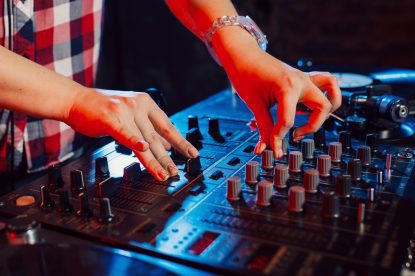 It’s no good having volume for volume’s sake, because all that’ll do is introduce distortion to your set. By mastering the art of gain control you can learn to get the maximum volume from each track without clipping off parts of the sounds.
It’s no good having volume for volume’s sake, because all that’ll do is introduce distortion to your set. By mastering the art of gain control you can learn to get the maximum volume from each track without clipping off parts of the sounds.
Some DJ software has the ability to normalise the sound volumes across all tracks but this doesn’t always fix the problem if one track happens to have much more punchy sounds than the other.
Ask any top DJ and they’ll tell you that the art of the seamless mix is in blending all of the sounds together from both tracks. This involves adjusting the low, medium and high frequency volumes as well as the master volume, and understand that 100% volume for 1 track might not be the same for another. So your gain control is vitally important.
The EQ lights go some way to telling you where your gain volume should be. If the lights are just peaking in to the red zone you’ve got a good base level. All your tracks should be doing this but it doesn’t tell the whole story.
You’ll learn from experience which tracks need more or less gain, if you just level them all out you’ll find one track will dominate another too much and your mix wont sound seamless.
To start with make sure the gain is lower than you think it should be. This gives you room to adjust upwards towards complimenting the current track’s sounds and volume. Be prepared to adjust on the fly.
Ever wondered why some DJs seem to be constantly turning dials and adjusting faders through their set? Gain control is why.
Song Selection
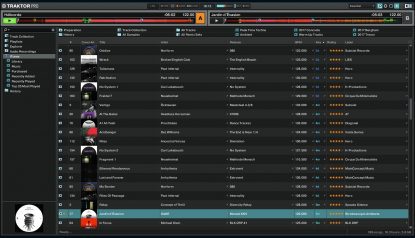 No matter how technically accomplished you are on the decks, nothing is going to save you if you can’t choose a record to save your life.
No matter how technically accomplished you are on the decks, nothing is going to save you if you can’t choose a record to save your life.
Song selection is about understanding the occasion, audience mood, venue size, and still having a few tracks up your sleeve to change things up if you need to.
The only real way you’ll be able to master this skill is by playing to a crowd, so make sure you build your confidence in front of smaller audiences until you feel more confident with what you’re doing.
If you’re a wedding or mobile DJ you’ll need to master this more than any other type. Because you’re expected to be an expert at reading the crowd, playing what they want and controlling the party.
So thrash metal right after the first dance isn’t going to work, neither is going in hard with your favourite trance track right after dinner!
Every event will require its own playlist. Find out from your client what their favourite tracks are, what genres of music they want and which they definitely don’t want.
I highly recommend creating playlists for different parts of the evening too. Laid back soul and romantic music when guests are arriving, background music during dinner, family friendly for earlier in the evening, anthems for the peak time set (usually after dinner and speeches), slow songs for couples dancing, etc.
Have playlists ready and your life will be a lot easier. I wrote a detailed article on how to organise DJ playlists which is definitely worth a read.
Equalising
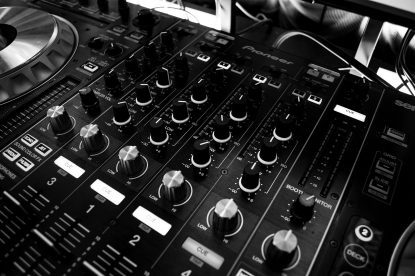 This is similar to gain control but in a much more refined way. Most modern mixers have low, medium and high frequency volume controls, often down to zero (known as kill control).
This is similar to gain control but in a much more refined way. Most modern mixers have low, medium and high frequency volume controls, often down to zero (known as kill control).
This allows you to completely drop the bass out of one track while keeping the mid range harmonies and percussive high frequencies. Or you could keep the bass-line and remove some of the rest of the dominant sounds.
For a more seamless mix and added creativity you can adjust the volumes of these frequencies during your mix to really play around with the sounds, blending the percussion fo both tracks by adjust both their high frequency volumes.
You could transition the beats and bass-lines between tracks by adjusting both low frequency volumes, before transitioning the rest of the percussion in the high frequencies. This is where real DJ skill comes in and you’ll master the art of the seamless mix. I’ve written about this and some other advanced DJ mixing techniques which are worth checking out.
Equalising lets you mix and blend in creative ways that a regular volume fader couldn’t. So experiment, practice and get creative.
There’s so much great DJ software out there that it was hard to narrow this down to half a dozen. But it’s vitally important you understand what they are, how they differ and which one might be best for you.
Here’s a quick introduction to 6 of the best, and there’s plenty more out there if you still want to look around:
Rekordbox
![]() A great piece of free software from Pioneer that makes it quick and easy to organise your tracks and files when you’re putting together a set.
A great piece of free software from Pioneer that makes it quick and easy to organise your tracks and files when you’re putting together a set.
Its arguably one of the most powerful systems for organising your music well and I know many DJs, especially mobile DJs find this workflow the easiest. Check out this video showing the latest features.
Serato DJ Pro
![]() One of the most popular pieces of software and an industry standard. There’s a free trial to get you started too. Includes virtual decks, track library, and offers full DVS support. Serato is very popular with hip hop and scratch DJs thanks to its high quality audio playback and versatility.
One of the most popular pieces of software and an industry standard. There’s a free trial to get you started too. Includes virtual decks, track library, and offers full DVS support. Serato is very popular with hip hop and scratch DJs thanks to its high quality audio playback and versatility.
It’s rock solid software has been refined over the years and has remained one of the best in the business.
Check out this video to discover all the latest features in Serato
Traktor Pro
 Now in it’s third generation, this is my personal favourite and has been for many years. Traktor Pro is ideal for those of you looking to transition to playing on club-sized sound systems and love to be creative with their tracks.
Now in it’s third generation, this is my personal favourite and has been for many years. Traktor Pro is ideal for those of you looking to transition to playing on club-sized sound systems and love to be creative with their tracks.
Its one of the most intuitive user interfaces and works seamlessly with all of Native Instrument’s DJ hardware.
Creating hot cues, loops, moving around within a track and mixing up to 4 decks of differing types is all possible with Traktor.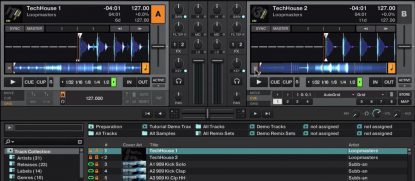
It has some industry leading effects that can transform any track and help you create some truly distinctive mix transitions. The software comes free with any Traktor Kontrol hardware or can be bought separately and then mapped to whatever midi controller or DJ hardware you have.
I find the unitive hardware and software combination really makes DJ-ing creatively even more fun. While Serato is for the scratch DJs, Traktor is for the loop and effect DJs.
Here’s a quick demo of how powerful Traktor software is when couples with Traktor Hardware
Virtual DJ
 A full digital DJ equipment setup for those of you looking to get started on a budget. A great way to try your hand at playing without having to fill your bedroom with kit.
A full digital DJ equipment setup for those of you looking to get started on a budget. A great way to try your hand at playing without having to fill your bedroom with kit.
While its not as powerful as the options above it is easy to master and a great place to start. They have some great youtube videos that walk you through the entire software and all its featured. Here’s a useful starting point.
Djay Pro
 A software package known for its user friendly and intuitive layout.
A software package known for its user friendly and intuitive layout.
A great choice for the beginner who doesn’t want to have to immediately upgrade once they’ve mastered the basics. With regular updates and a subscription model for added features its a novel approach to DJ software. Worth checking out.
Mixxx
 Free software which integrates with your iTunes audio library, can offer MIDI controller support, and even live internet broadcasting.
Free software which integrates with your iTunes audio library, can offer MIDI controller support, and even live internet broadcasting.
Its a little more tricky to set up but its integration with your current library might be just what you need to get started. Here’s a useful video to see if Mixxx is the right fit for you.
My recommendation
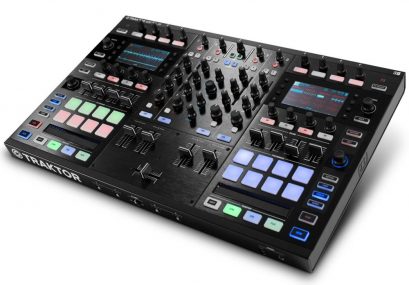 It has to be Traktor for me, partly because I love their hardware which is industry leading, versatile, unitive with a very solid build quality.
It has to be Traktor for me, partly because I love their hardware which is industry leading, versatile, unitive with a very solid build quality.
On top of that the software is feature rich and over the years has handled everything I’ve thrown at it. Live mixing between vinyl and digital, effects, looping, hot cue creation and usage, backup when hardware fails and rock solid reliability.
While other software can be cheaper and a good place to start, you’ll inevitably move up to the more pro industry standards of Traktor or Serato once your mixing skills and professional requirements increase.
So why not start there anyway and save yourself the need to switch later on?
Everyone is different so by all means try them all and see what works best for you.
Every DJ needs plenty of kit to play with, so here’s a quick rundown of the hardware you’re going to need.
Basic equipment for DJing
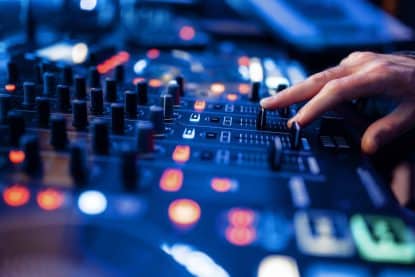 A pair of turntables if you’re spinning vinyl, or a DJ controller if you want to stay firmly in the digital world. I have both as they offer different benefits.
A pair of turntables if you’re spinning vinyl, or a DJ controller if you want to stay firmly in the digital world. I have both as they offer different benefits.- A laptop with a suitable interface and software installed. Going cheap wont cut it, get something stable, most Pro DJs opt for a Macbook Pro.
- A mixer so you can do all sorts of techniques. This is the key piece of equipment that brings everything together and allows you to create your own signature sound. I’ve written about finding the right mixer for you here.
- Slipmats to protect your vinyl if you want to start scratching. Remove the rubber platter on your decks and slap on some furry slipmats!
- Studio quality headphones so you can hear your sound loud and clear, no matter where you are. I always opt for over-ear headphones rather than in-ear buds.
- Cabling such as TRS and XLR cables for balanced audio, and Aux cords for most common types of equipment. Most likely needed if you’re a club or mobile DJ.
- A specialist interface between your laptop and mixer if it doesn’t have a built in sound card. More on DJing with a laptop here. Native Instruments make pro quality high end sound cards that connect to your laptop via USB.
More Advanced DJ Hardware
All-In-One Controllers
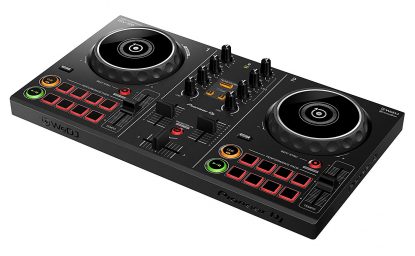 Pioneer DDJ-200: A great entry-level controller for those looking to build a custom setup on a budget
Pioneer DDJ-200: A great entry-level controller for those looking to build a custom setup on a budget- Pioneer XDJ-RX: A high end Pro controller for the DJ who wants everything in one place. Compatible with RecordBox software
- Denon DJ MC7000: One of the most versatile and adaptable controllers on the market — trusted by some of the world’s biggest DJs
Vinyl Decks / DJ Turntables
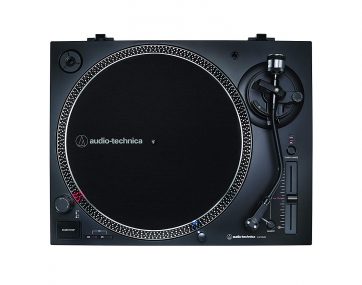 Technics SL-1200 Mk II: The classic turntable we all grew up dreaming of using. Only currently available secondhand as they were discontinued in 2010. Still considered one of the best.
Technics SL-1200 Mk II: The classic turntable we all grew up dreaming of using. Only currently available secondhand as they were discontinued in 2010. Still considered one of the best.- Stanton T92: A stylish vinyl deco with a USB output so you can use it with the latest mixers with few headaches.
- Audio Technica AT-LP1240: Another USB deck that’s inspired by the groundbreaking approach of the SL-1200 series. A great alternative if you can’t find one of the originals on eBay
Honorable Mentions:
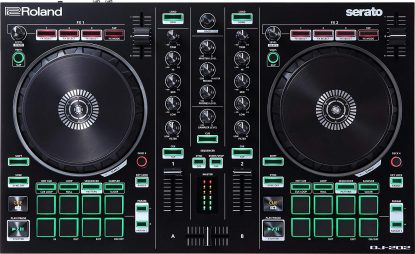 Roland DJ-202 DJ Controller: A classic two-channel controller used by some of the world’s best DJs. Comes complete with 8 performance pads for sampling and cueing, and includes an onboard sequencer
Roland DJ-202 DJ Controller: A classic two-channel controller used by some of the world’s best DJs. Comes complete with 8 performance pads for sampling and cueing, and includes an onboard sequencer- Pioneer DM-40 Speakers: Bass-enhanced speakers that are designed for a deep and rich sound. Good for home or studio use when practicing and preparing a set. They work with any DJ setup just fine and the built in amp saves space.
- TurboSound IQ15 Active Speaker: A great sound system for the mobile DJ who wants to be able to travel with their setup with the minimum of fuss.
I’ve been teaching you all the good things you should be doing and the key things you should know.
But it’s important to also know how things can go wrong and what can easily make you look unprofessional.
So here’s a handy list of the most common mistakes I see DJs making.
Using Too Many Fancy Options
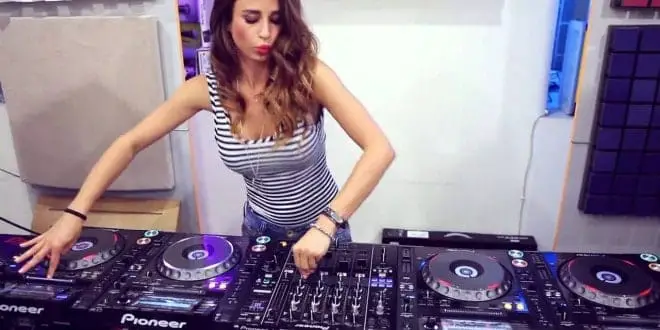 Just because you have 80 buttons right there in front of you doesn’t mean you have to try and use every one of them during your mix!
Just because you have 80 buttons right there in front of you doesn’t mean you have to try and use every one of them during your mix!
Stick to what you know, master the basics, and use your skills to create a mix people actually want to hear.
No one will be impressed with endless looping, no matter how technically skilled you may be, if it doesn’t sound good to those that are listening.
Sometimes less is more, or at the very least a masterful touch of effects, loops, scratching, and mixing are what will share your expertise with your audience..
Learn the skills rather than throw everything at the crowd. They will appreciate your abilities much more than you trying to show off.
DJing Without Any Direction
When you’re starting out it’s unlikely that you’ll already be one of the world’s best all round DJs, so don’t try to be. Have a clear progression for your DJ career in mind, and put in the work to follow it step by step. This applies to all types of DJ.
Rome wasn’t built in a day so don’t expect to be the world’s greatest DJ overnight.
Put in the hours and practice, know your skill level and only take on gigs you know you can perform well at.
Start with local gigs for friends and family, progress to bars and then pitch to clubs when you’re ready. If you want to learn how to get more gigs read my article on the subject. The same applies to all other types of DJ. Keep the momentum going, share locally and set goals to build upon your skills and your business.
Having clear goals will give you something to aim for. You’ll see (or rather hear) noticeable improvements.
Not Knowing Your DJ equipment well
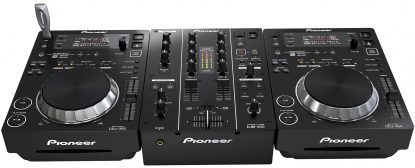 This is basically criminal, but there are so many DJs out there who do it every single time they hit the decks.
This is basically criminal, but there are so many DJs out there who do it every single time they hit the decks.
The best way to sound professional and skilled is to be professional and skilled! This means knowing your DJ software and hardware inside out.
Take time to play around with it, experiment, put it through its paces and find out what it can do. More importantly find out what you can do and where your limits currently are.
If you want to get the most out of your kit then you’e going to have to invest some time to get to know your software. Put the hours in.
Monitoring at the wrong volume
There is such a thing as too much volume, even for a DJ. If you want to treat your audience to a great mix you’re going to want to get the decibel levels just right when monitoring your music.
This isn’t the volume the crowd hears. Its the volume your monitor speakers (or possibly just headphones) is kicking out when you’re attempting a mix or previewing the next track.
If the monitor volume is too low you’ll likely not hear if your mix is out of sync or has sound clashes.
If its too loud you’ll not only distort some of the crisp sounds you’ll want to make sure you can hear for seamless mixes, you’ll also damage your ear drums.
Getting monitoring just right is another skill you’ll need and it can vary from venue to venue, sound system to sound system.
Be sure to perfect the monitoring levels for your given space and keep in mind how prolonged exposure to loud sounds can cause ear damage over time.
Over-Mixing
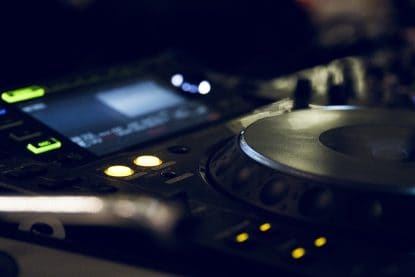 If you go over the top by mixing over and over again you’re going to end up with a track that tries to do everything, but sadly achieves nothing but a big mess of sounds.
If you go over the top by mixing over and over again you’re going to end up with a track that tries to do everything, but sadly achieves nothing but a big mess of sounds.
If you find yourself going too far down this route when practicing, scrap the mix and start again. You’ll find it’s a lot easier to keep things simple and perfect the elegant approach.
Listen to the world’s most famous DJs, you’ll notice their mixes are tight, seamless and make refined and subtle use of loops and effects. They rarely go crazy and throw everything at a mix.
There’s a reason for that!
There are plenty more mistakes DJs can make so we’re dedicated an entire article to it. Well worth a read to make sure you’re not making any of these mistakes.
Whether you like it or not every DJ needs a social media following if they’re going to make it big, and the great thing about it is that it’s free to do.
Being a DJ often means creating a fan-base and you’ll get more gigs if you have a following too.
Here’s everything you need to know to start taking your DJing skills to the masses.
Pick the Right Network
 Clearly if you’re a DJ you don’t need to be on LinkedIn or Pinterest, but you do need to be sharing videos on Facebook and blowing up on Instagram.
Clearly if you’re a DJ you don’t need to be on LinkedIn or Pinterest, but you do need to be sharing videos on Facebook and blowing up on Instagram.
Choosing the right platform will set the tone for the rest of your social media campaign by ensuring you’re showcasing your skills to an audience that actually cares about what you’re doing.
Fill Out Your Profile
It only takes a couple of minutes to add a profile picture, stage name and a little bio, so why would you do yourself a disservice and not bother doing it?
Spend a little bit of time seeking inspiration from DJs you admire, then build in a little bit of the inspiration you find with your own ideas.
It’ll give you a presence and a reputation you can then build on over the coming weeks and months.
Follow the Best Clubs and DJs
If you want to build a following you’re going to have to approach people to begin with, because they’re not going to know who you are.
There’s no shame in adding local clubs, promoters and DJs to your followers, as well as some of the biggest names in the industry.
You’re hoping that the local people are the ones who get in touch to book you and discuss a demo set, whilst the international stars increase your chances of being seen by the millions of people who are fans of their music.
Share Regular Content
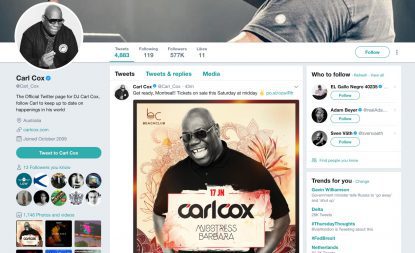 If you want your followers to get bored and unfollow you, there’s no better way to achieve it than with sporadic, poor quality content.
If you want your followers to get bored and unfollow you, there’s no better way to achieve it than with sporadic, poor quality content.
If on the other hand you want to make a name for yourself for all the right reasons, you’re going to want a conveyor belt of set lists and club performance videos. The secret is to be original, creative, and self promotional.
You’re not constantly advertising your availability and touting for work. But what you are doing is showcasing your talents so people are going to want to stream and book you.
The Occasional Paid Ad is Worth it
Paid ads are a great way to boost the reach of your posts, but don’t go crazy with them. If you’re advertising your first gig or showcasing a new demo, a paid ad may be a great idea to try.
Set yourself a $20 budget, and monitor the success of your campaign over the next 7 days.
It’ll give you a clear indication as to whether your following is big enough to warrant paid ads, or you would be better off continuing to build it first.
If you want to know how to DJ, you’re going to need to know how to get your first gig.
Luckily it’s simple when you know how, so here’s some handy pointers.
Know Your Local Scene
 There are always all sorts of niche music nights tucked away that only the true music lovers seem to know about, so why aren’t you speaking to them already?
There are always all sorts of niche music nights tucked away that only the true music lovers seem to know about, so why aren’t you speaking to them already?
You may well find there’s a little club just around the corner that’s looking to fill an open session night with DJs just like you.
You should have a list of all local nightclub venues, all private function rooms in hotels and even pubs with function rooms near you.
Speak to them, get on their contact lists, keep in touch and remind them you exist.
Work With Other DJs
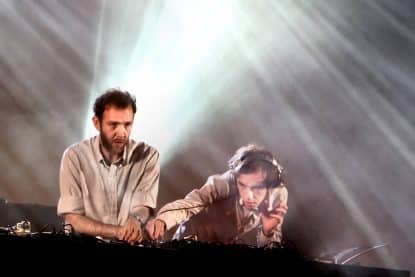
If there’s 2 of you, you can offer the club twice as much talent on the night. Often for half the price per DJ. There’s a financial hit here but together maybe you can do something no other DJ is doing in your area.
Find someone you like to partner with, and then decide whether you want to go back to back, share the night’s duties or double up and get up on stage together. Create a theme or brand around the two of you. Maybe one is better on the mic than the other? Maybe one can scratch mix while the other is a demon and creating mashups of multiple tracks? Find your niche.
Send Demos to potential clients
Okay, so the days of posting off tapes may be long gone, but there’s still no substitute for putting your music directly in front of the people in charge of booking talent.
If you send off a link to your portfolio then you’ll at least be getting your name out there.
You may not hear back from everyone straightaway, but be patient and good things will start to happen. Don’t bug people too much but be sure to let them know you’re still available and have new mixes worth checking out.
Advertise Your Availability on Social Media
 Its always wise to let potential clients know you exist. Especially if you’re a mobile DJ, but this could be applied to club DJing too. Just be careful as you don’t want to be doing this everyday or people will start to think you can’t secure any work!
Its always wise to let potential clients know you exist. Especially if you’re a mobile DJ, but this could be applied to club DJing too. Just be careful as you don’t want to be doing this everyday or people will start to think you can’t secure any work!
Promoting on social media is great if you want to reach new people, get booked for seasonal gigs, or introduce yourself to local promoters and nightclubs. Its all about keeping up a sustained campaign of engagement and promotion.
Put On Your Own Night
 Got a few DJ friends, but no club slots booked up? If you can find a venue that’s willing to have you, you could put on your own night.
Got a few DJ friends, but no club slots booked up? If you can find a venue that’s willing to have you, you could put on your own night.
This takes some effort and teamwork but many of the world’s best club nights started this way.
Get the word out as soon as you secure the booking and promote it heavily. If you town or city has the right demographic of people you’ll have the place full to the rafters in no time at all.
For a lot more detail on getting more DJ gigs read my article on the subject. I’ve covered this topic at length to help you boost your DJ career. If you want to DJ at music festivals I’ve written about that too.
Last but not least, we come to perhaps the biggest thing you need to know when you want to know how to DJ.
None of the world’s biggest DJs were born able to do what they can do right now — it took years of practice and perseverance, and it’ll take you at least as long.
Set Yourself a Goal
Maybe you want to secure your first gig by the end of the month, or perhaps you want 10,000 streams for your next mix? It doesn’t matter what it is, set yourself a quantifiable goal that it’ll be easy to determine whether you’ve achieved or not.
Setting a goal like ‘DJ more often’ just isn’t going to get you very far, unfortunately. Here’s a few goals you could set yourself, from the simple to the career changing.
- Add hot cues and loop markers to every track in your library
- Create playlists for every music genre and type of event you might be DJing at
- Try every effect and button on your mixer or controller to fully understand how to use it
- Create a DJ mix to upload to Sound Cloud or Mix Cloud every week (or month if you have less time)
- Research all the local competition, work out what they’re offering and how you can offer something different
- Build a database of all nightclubs, venues, hotels and pubs with a given distance from where you live and contact them all
- DJ at 5 gigs in your first year (paid or otherwise) to get your name out there
Remember Why You Started in the First Place
 You wanted to know how to DJ because you thought it would be fun, so why should you ever lose sight of that?
You wanted to know how to DJ because you thought it would be fun, so why should you ever lose sight of that?
It’s a great way to spend your time, relax, and make amazing new music. It really doesn’t have to be anything more than that if you don’t want it to be. At the very least you should be enjoying what you do just because its enjoyable.
The business side of things is a happy byproduct of your DJ-ing passion.
When you get frustrated at the lack of gigs, or mess up a mix, or have a bad night for whatever reason, remember your love for the music, the thrill of nailing the perfect mix and the joy you can bring others through your DJ skills.
Listen to Your Earlier mixes, radio shows or tracks
One of the best ways to keep practicing is to keep your motivation sky-high, and the best way to do that is by listening to your earlier mixes to see how far you’ve come.
Uploading them to somewhere public helps to archive them too and get feedback from others. Get an account at Soundcloud.com or Mixcloud.com
It’ll give you the confidence that you’re still improving, and it’ll give you all the motivation you need to put in a few hours of practice when you get home from work tonight.
You’ll probably also laugh at some of your less than perfect mixes in the past and feel happy that your have come a long way since then. You can also analyse what went wrong and know how to avoid the same mistakes in future. Its all good research, be proud of your DJ-ing abilities as you grow.
More DJ tutorials and advice
I’ve told you just about everything there is to know about becoming a DJ, all you need to do now is start putting these wise words into practice.
They’ll give you direction, ideas, and focus so you can enjoy your hobby whilst making plenty of progress both in skills and business.
Just what you need when you want to pursue a passion project by taking your DJ skills in an exciting new direction.
There are plenty of other ways to improve your DJ skills, check out these articles.

